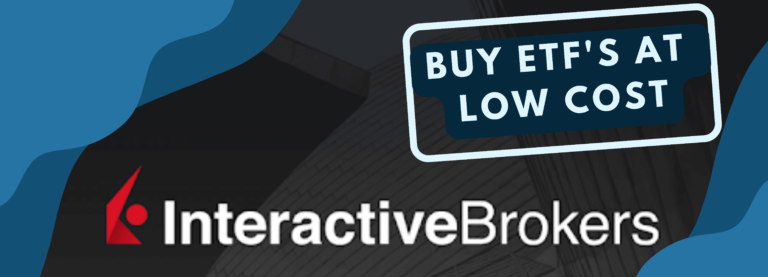5 Passive Investment Ideas
If you’re looking for ways to grow your wealth with low effort, then passive investment options may be the solution you’re looking for. “5 Passive Investment Ideas” will explore various investment strategies.
You can buy the best passive income ETFs on InteractiveBrokers for a convenient and accessible way to implement these strategies. Whether you’re a beginner or an experienced investor, this guide will provide insights on the pros and cons of each option, helping you make informed decisions on the best passive investment approach for you.
Index Funds/ETFs
Index funds and ETFs provide a low-cost, diversified investment option that tracks a market index. These types of investments are designed to offer exposure to a broad range of assets, with the aim of reducing risk and increasing diversification.
Pros:
• Low cost: Index funds and ETFs typically have lower fees compared to actively managed funds.
• Diversification: These investments provide exposure to a wide range of assets, reducing risk.
• Simplicity: Index funds and ETFs are simple to understand and easy to invest in.
Cons:
• Limited Potential for Outperformance: These investments track a market index, meaning that their performance is limited to that of the index.
• Market Risk: The value of these investments is directly linked to the market, meaning that they can be impacted by market volatility.
Dividend-Paying Stocks
Investing in dividend-paying stocks offers a way to earn regular income from your investments. This type of investment involves buying stocks in companies that regularly pay dividends to their shareholders.
Pros:
• Regular Income: Dividend-paying stocks provide a regular income stream in the form of dividends.
• Potential for Capital Appreciation: In addition to the income provided by dividends, these stocks also have the potential for capital appreciation.
• Diversification: Investing in a range of dividend-paying stocks can help to diversify your portfolio and reduce risk.
Cons:
• Market Risk: The value of these investments is linked to the market, meaning that they can be impacted by market volatility.
• Dependent on Company Performance: The income provided by these stocks is dependent on the performance of the underlying company.
• Tax Implications: Dividends are taxed as income, meaning that they can have a significant impact on your tax bill.
Real Estate Investment Trusts (REITs)
Real Estate Investment Trusts (REITs) offer an opportunity to invest in income-generating properties, usually in the form of stocks. REITs own and operate a portfolio of properties, such as apartments, office buildings, and shopping centers.
Pros:
• Regular Income: REITs are required to distribute a certain portion of their earnings to shareholders in the form of dividends.
• Potential for Capital Appreciation: In addition to the income provided by dividends, REITs also have the potential for capital appreciation.
• Diversification: Investing in a REIT provides exposure to the real estate market, helping to diversify your portfolio.
Cons:
• Market Risk: The value of REITs is linked to the real estate market, meaning that they can be impacted by market conditions.
• Dependent on Real Estate Market: The performance of REITs is dependent on the real estate market, which can be volatile.
• Tax Implications: Dividends from REITs are taxed as income, meaning that they can have a significant impact on your tax bill.
Bond Funds
Bond funds invest in a portfolio of bonds, offering the opportunity to earn interest income from your investments. This type of investment is a low-risk option, with the aim of providing a steady income stream.
Pros:
• Regular Income: Bond funds provide a regular income stream in the form of interest payments.
• Low Risk: Bonds are considered to be a low-risk investment, making bond funds a good option for those looking for stability.
• Diversification: Investing in a bond fund provides exposure to a range of bonds, reducing risk and increasing diversification.
Cons:
• Low Potential for Capital Appreciation: Bond funds typically offer lower potential for capital appreciation compared to stocks.
• Interest Rate Risk: The value of bonds and bond funds can be impacted by changes in interest rates.
• Credit Risk: The issuer of the bond may default on their payments, resulting in a loss for the bondholder.
Crypto Staking
Crypto staking involves holding onto a specific cryptocurrency and participating in maintaining the network to earn rewards. This type of passive investment is only available for certain cryptocurrencies that use a proof-of-stake consensus mechanism.
Pros:
• Potential for High Rewards: The rewards for crypto staking can be high, especially for smaller holders.
• Easy to Participate: Crypto staking can be easy to participate in, with many platforms offering staking services.
• Diversification: Investing in crypto staking can help to diversify your investment portfolio.
Cons:
• High Risk: Cryptocurrency is considered to be a high-risk investment, and staking is no exception.
• Dependent on Network Performance: The rewards for crypto staking are dependent on the performance of the network.
• Volatility: The value of the cryptocurrency being staked can be highly volatile, meaning that staking rewards can be impacted
In conclusion, there are several passive investment options available to those looking to grow their wealth over the long-term. Each option offers its own set of pros and cons, so it’s important to carefully consider your personal financial goals and risk tolerance before making a decision. Whether you choose index funds and ETFs, dividend-paying stocks, REITs, bond funds, or crypto staking, the key to success is to have a well-diversified investment portfolio and to stick with your strategy over the long-term.
Invest in the best passive income ETFs on InteractiveBrokers for a convenient and accessible way to grow your wealth with passive investment strategies.







